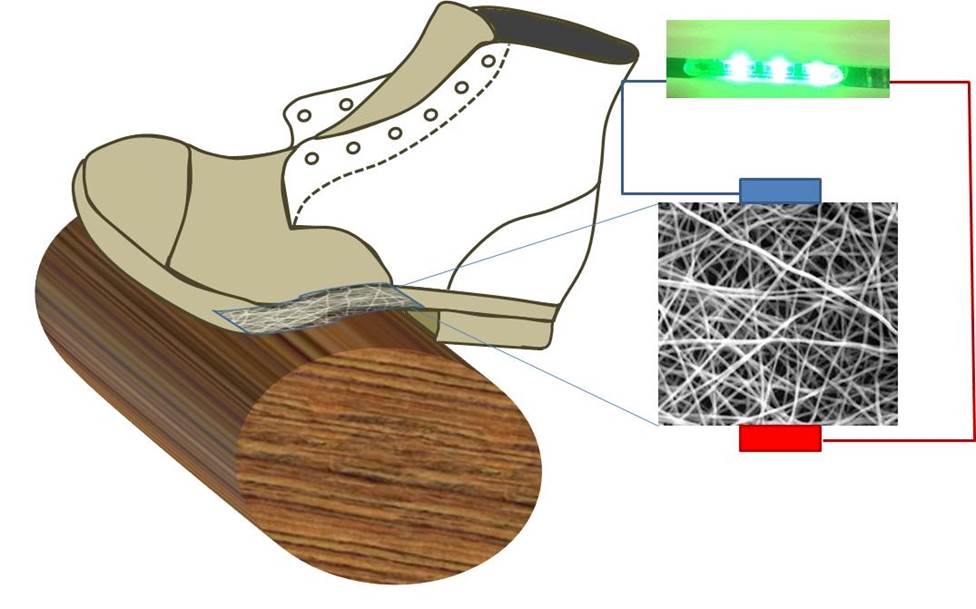▼ Reference
- Bera B, Sarkar M D. Gold Nanoparticle Doped PVDF Nanofiber Preparation of Concurrently Harvesting Light and Mechanical Energy. IOSR Journal of Applied Physics (IOSR-JAP) 2017; 9: 05.
- Bu N, Huang Y, Ding Y, Yin Z. An Energy-Harvesting Device Based on Mechano-Electrospun Aligned Poly(vinylidene fluoride) Fiber Arrays. Sensors and Materials 2016; 28: 757.
- Chang C. Direct-Write Piezoelectric Nanogenerator by Near-Field Electrospinning. PhD Thesis. University of California, Berkeley. Fall 2009. Open Access
- Ji J H, Lee G, Koh J H. Synthesis of a nitrogen doped reduced graphene oxide based ceramic polymer composite nanofiber film for wearable device applications. Sci Rep 2022; 12: 15583. Open Access
- Ji S H and Yun J S. Fabrication and Characterization of Aligned Flexible Lead-Free Piezoelectric Nanofibers for Wearable Device Applications. Nanomaterials 2018; 8(4): 206; doi:10.3390/nano8040206 Open Access
- Liu Z H, Pan C T, Lin L W, Huang J C, Ou Z Y. Direct-write PVDF nonwoven fiber fabric energy harvesters via the hollow cylindrical near-field electrospinning process. Smart Mater. Struct. 2014; 23: 025003.
- Lu Y, Amroun D, Leprince-Wong Y, Basset P. A paper-based electrostatic kinetic energy harvester with stacked multiple electret films made of electrospun polymer nanofibers. . J. Phys.: Conf. Ser. 2016; 773: 012032. doi: 10.1088/1742-6596/773/1/012032.
- Mandal D, Yoon S, Kim K J. Origin of Piezoelectricity in an Electrospun Poly(vinylidene fluoride-trifluoroethylene) Nanofiber Web-Based Nanogenerator and Nano-Pressure Sensor. Macromol. Rapid Commun. 2011; 32: 831.
- Mirjalali S, Bagherzadeh R, Abrishami S, Asadnia M, Huang S, Michael A, Peng S, Wang CH, Wu S. Multilayered Electrospun/Electrosprayed Polyvinylidene Fluoride+Zinc Oxide Nanofiber Mats with Enhanced Piezoelectricity. Macromolecular Materials and Engineering 2023; 308: 2300009. Open Access
- Pan C T, Yen C K, Wang S Y, Lai Y C, Lin L, Huang J C, Kuo S W. Near-field electrospinning enhances the energy harvesting of hollow PVDF piezoelectric fibers. RSC Adv 2015a; 5: 85073.
- Pan C T, Yen, C K, Wu H C, Lin L, Lu Y S, Huang J C C, Kuo S W. Significant piezoelectric and energy harvesting enhancement of poly(vinylidene fluoride)/polypeptide fiber composites prepared through near-field electrospinning. J. Mater. Chem. 2015; 3: 6835.
- Pan C T, Yen C K, Liu Z H, Li H W, Kuo S W, Lu Y S, Lai Y C. Poly(γ-benzyl α, l-glutamate) in Cylindrical Near-Field Electrospinning Fabrication and Analysis of Piezoelectric Fibers. Sensors and Materials 2014; 26: 63.
- Persano L, Dagdeviren C, Su Y, Zhang Y, Girardo S, Pisignano D, Huang Y, Rogers J A. High performance piezoelectric devices based on aligned arrays of nanofibers of poly(vinylidenefluoride-co-trifluoroethylene). Nature Communications 2013; 4: 1633. Open Access
- Saqib Siddiqui, Do-Il Kim, Eun Roh, Le Thai Duy, Tran Quang Trung, Minh Triet Nguyen, Nae-Eung Lee. A Durable and Stable Piezoelectric Nanogenerator with Nanocomposite Nanofibers Embedded in an Elastomer under High Loading for a Self-Powered Sensor System. Nano Energy 2017b. Article in press
- Shafii C. Energy Harvesting Using PVDF Piezoelectric Nanofabric. MSc Thesis. University of Toronto 2014. Open Access
- Siddiqui S, Lee H B, Kim D I, Duy L T, Hanif A, Nae-Eung Lee N E. An Omnidirectionally Stretchable Piezoelectric Nanogenerator Based on Hybrid Nanofibers and Carbon Electrodes for Multimodal Straining and Human Kinematics Energy Harvesting. Adv. Energy Mater. 2017; 1701520.
- Yun J S, Park C K, Jeong Y H, Cho J H, Paik J H, Yoon S H, Hwang K R. The Fabrication and Characterization of Piezoelectric PZT/PVDF Electrospun Nanofiber Composites. The Fabrication and Characterization of Piezoelectric PZT/PVDF Electrospun Nanofiber Composites. Nanomater Nanotechnol, 2016, 6:20. Open access
- Zaarour B, Zhu L, Huang C, Jin X. Enhanced piezoelectric properties of randomly oriented and aligned electrospun PVDF fibers by regulating the surface morphology. J. Appl. Polym. Sci. 2019; 136: 47049.
▼ Credit and Acknowledgement
Author
Wee-Eong TEO View profile
Email: weeeong@yahoo.com
 ElectrospinTech
ElectrospinTech


